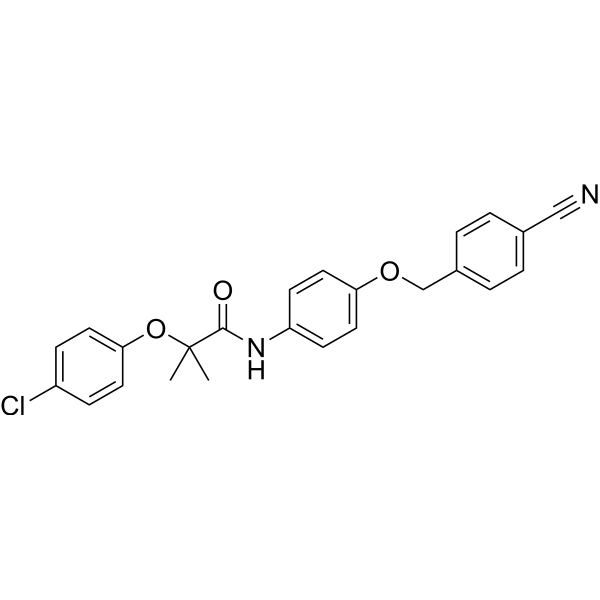Physicochemical Properties
| Molecular Formula | C24H21CLN2O3 |
| Molecular Weight | 420.888145208359 |
| Exact Mass | 420.124 |
| CAS # | 2493239-46-4 |
| PubChem CID | 154573764 |
| Appearance | White to off-white solid powder |
| LogP | 5.2 |
| Hydrogen Bond Donor Count | 1 |
| Hydrogen Bond Acceptor Count | 4 |
| Rotatable Bond Count | 7 |
| Heavy Atom Count | 30 |
| Complexity | 593 |
| Defined Atom Stereocenter Count | 0 |
| SMILES | ClC1C=CC(=CC=1)OC(C(NC1C=CC(=CC=1)OCC1C=CC(C#N)=CC=1)=O)(C)C |
| InChi Key | OSSMPMZJYDZMFX-UHFFFAOYSA-N |
| InChi Code | InChI=1S/C24H21ClN2O3/c1-24(2,30-22-11-7-19(25)8-12-22)23(28)27-20-9-13-21(14-10-20)29-16-18-5-3-17(15-26)4-6-18/h3-14H,16H2,1-2H3,(H,27,28) |
| Chemical Name | 2-(4-chlorophenoxy)-N-[4-[(4-cyanophenyl)methoxy]phenyl]-2-methylpropanamide |
| HS Tariff Code | 2934.99.9001 |
| Storage |
Powder-20°C 3 years 4°C 2 years In solvent -80°C 6 months -20°C 1 month |
| Shipping Condition | Room temperature (This product is stable at ambient temperature for a few days during ordinary shipping and time spent in Customs) |
Biological Activity
| ln Vitro | AMPK activator 4 (compound B10) (0–20 μM; 12–24 hours) causes AMPK and its downstream protein ACC to become phosphorylated[1]. LKB1 is necessary for AMPK phosphorylation mediated by AMPK activator 4[1]. When HepG2 cells are treated with AMPK activator 4 at 10–20 μM for 72 hours, their viability is slightly decreased[1]. |
| ln Vivo | AMPK activator 4 (100 mg/kg; administered intragastrically; daily for 9 weeks) exhibits anti-hyperglycemic properties[1]. |
| Cell Assay |
Western Blot Analysis[1] Cell Types: C2C12 myotubes, HepG2 and HuH-7 cells Tested Concentrations: 0-20 μM Incubation Duration: 12-24 hrs (hours) Experimental Results: Induced dose-dependently phosphorylation of ACC in C2C12 myotube cells, and the phosphorylation of ACC was highly consistent with the phosphorylation of AMPK. Increased the phosphorylation of AMPK and ACC in human hepatocarcinoma HepG2 and HuH-7 cells. |
| Animal Protocol |
Animal/Disease Models: db/db mice (5-week old)[1] Doses: 100 mg/kg Route of Administration: intragastric (po)administration; daily for 9 weeks Experimental Results: Dramatically lowered the fasting blood glucose in db/db mice (2-6 weeks). Dramatically improved insulin resistance in db /db mice (for 9 weeks). The body weight and the serum levels of alanine aminotransferase (ALT) and aspartate aminotransferase (AST) (two markers of liver injury) were not Dramatically affected. |
| References |
[1]. Discovery of AdipoRon analogues as novel AMPK activators without inhibiting mitochondrial complex I. Eur J Med Chem. 2020;200:112466. |
Solubility Data
| Solubility (In Vitro) | DMSO : 250 mg/mL (593.98 mM) |
| Solubility (In Vivo) |
Solubility in Formulation 1: ≥ 2.08 mg/mL (4.94 mM) (saturation unknown) in 10% DMSO + 90% Corn Oil (add these co-solvents sequentially from left to right, and one by one), clear solution. For example, if 1 mL of working solution is to be prepared, you can add 100 μL of 20.8 mg/mL clear DMSO stock solution to 900 μL of corn oil and mix evenly. (Please use freshly prepared in vivo formulations for optimal results.) |
| Preparing Stock Solutions | 1 mg | 5 mg | 10 mg | |
| 1 mM | 2.3759 mL | 11.8796 mL | 23.7592 mL | |
| 5 mM | 0.4752 mL | 2.3759 mL | 4.7518 mL | |
| 10 mM | 0.2376 mL | 1.1880 mL | 2.3759 mL |
